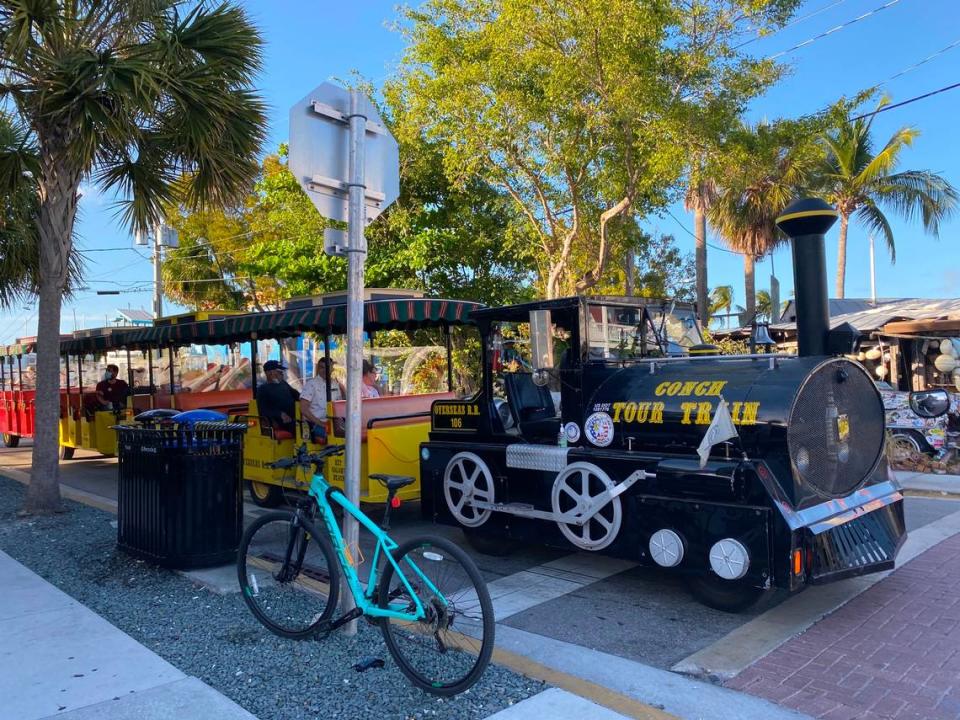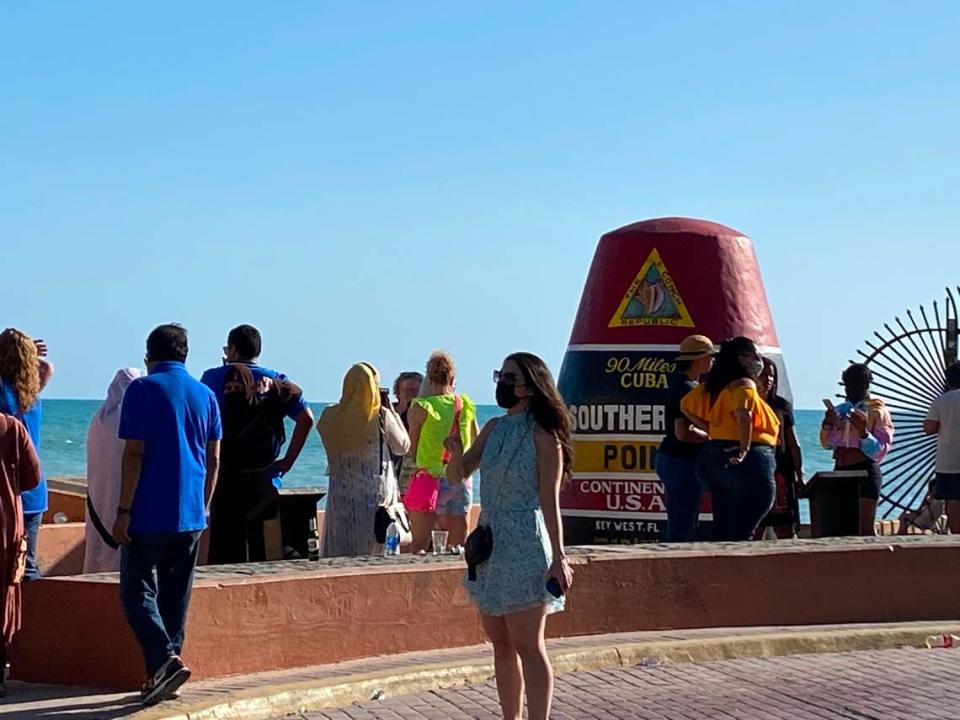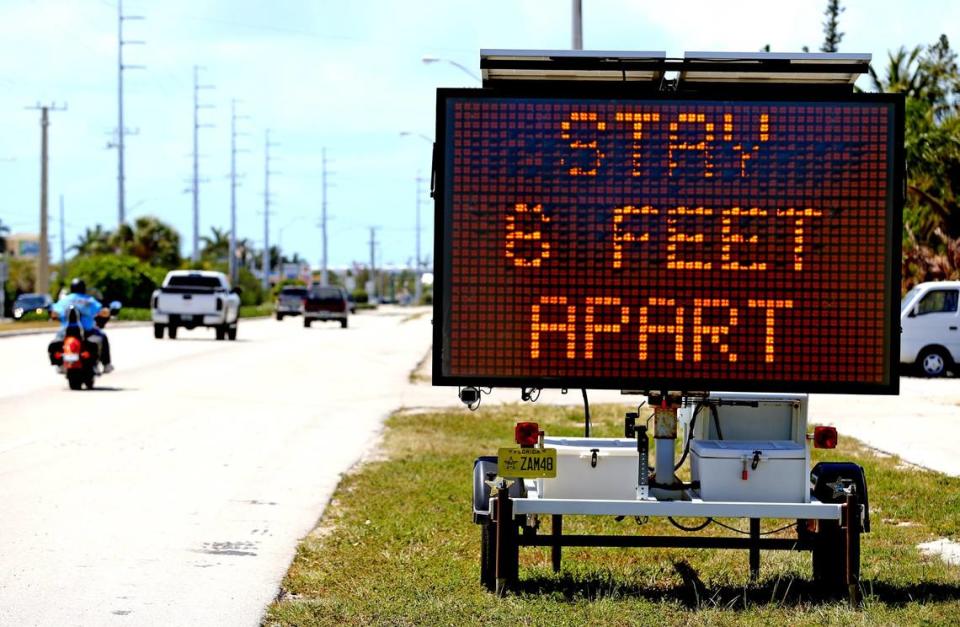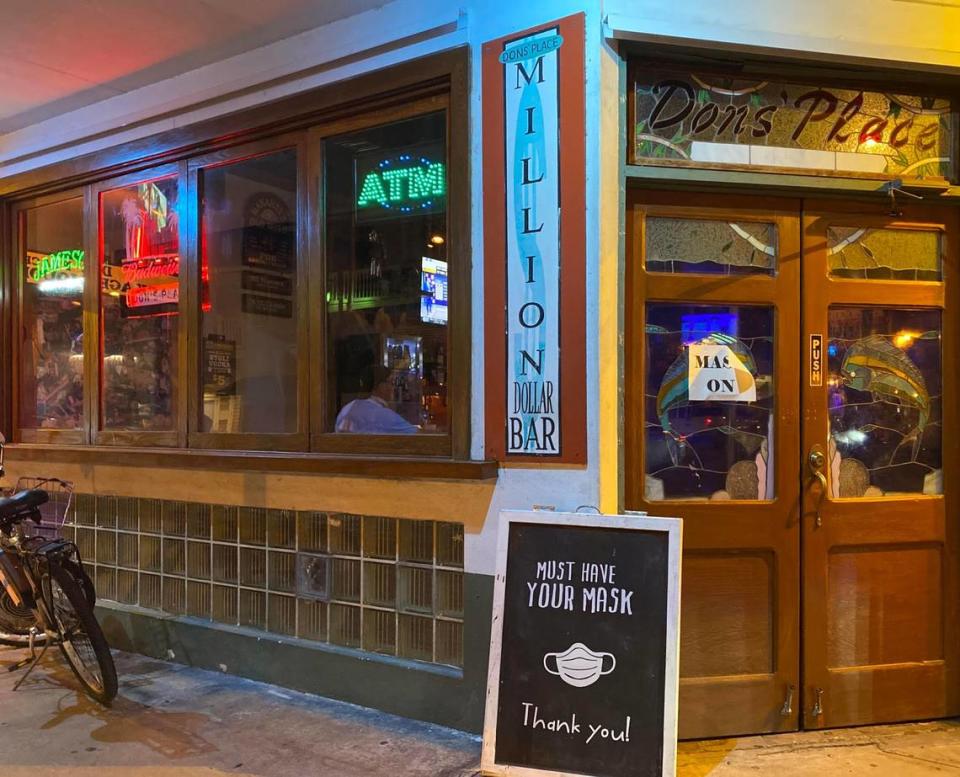What happened to the Keys after a pandemic shutdown? It’s a comeback story for tourism
The Florida Keys closed for business this time last year. Roadblocks went up. The chain of islands fell silent.
Except for residents and workers, no one was allowed in.
It was a body blow to a slice of Florida whose economy revolves around tourism money. But as cases and deaths from the building pandemic rose across Florida, Keys leaders wanted to seal off Monroe County from danger. The thinking was that a raging pandemic would do more long-term harm to people and their livelihoods than a temporary shutdown.
But would the Keys be able to recover?
A year after the Keys did what no other place in Florida could do — put up barriers to keep people out — the lifeblood of tourism has returned. The crowds are back. Tax revenues are up.
Duval Street is packed on weekends and nights. Restaurants and bars are finding their groove again. Day trippers from Miami-Dade are crowding the only highway in and out.
While some question whether all these visitors, many of them clumped together and unmasked, is a good thing when people are still dying in a pandemic, one thing is certain: People are coming with their cash and credit cards. And that makes the people who run the restaurants, shops and hotels very happy.
“If it continues like this, it’s going to be my best year ever,” said Jamie Snediker, who owns the Southernmost Tattoo shop and a fishing party boat. “Town is so damn packed.”
When the Keys shut down to visitors about a year ago in the early days of the COVID-19 pandemic, many in the tourism-reliant island chain fell into an economic free fall. Uncertainty coursed through the industry without the droves of big spenders.
Key West streets were eerily empty day and night. Monroe County’s checkpoints at the entrances to the Keys stayed up for two months.
March brought business shutdowns as elected leaders grappled with trying to slow the spread of COVID. Bars and hotels closed and restaurants operated with limitations. Only businesses deemed “essential,” like grocery stores, were allowed to remain open.
“What the hell am I going to do with myself now?” Snediker recalls thinking back then.
The owner of the Southernmost Tattoo shop and a fishing party boat, Gulfstream Fishing, was left stunned. But a year later in Key West, the 2021 high tourism season has provided a big comeback — at least for some.

ECONOMIC TURNAROUND
If the 5% tourist development tax Monroe County collects on hotel and motel lodgings and vacation rentals is an indicator, the Keys are experiencing an economic recovery.
In the spring and early summer last year — while the checkpoints on the 18 Mile Stretch of U.S. 1 and Card Sound Road were being staffed by sheriff’s office deputies and various county workers, and while the governor’s executive order banning vacation rentals was in effect — lodging tax revenue nosedived.
“You can see that collections in March 2020 were higher than March 2019, and then collections began to decline in April, May and June of 2020,” said Sam Steele, Monroe County’s tax collector.
But by the late summer and early fall, things were looking up, and in some cases, better than the year before:
▪ In October 2019, for instance, the county collected about $1.8 million in tourist development taxes. In October 2020, that rose to nearly $2.6 million, according to data provided by the tax collector’s office.
▪ In May and June, by contrast, the county collected less than $500,000 each month.
▪ By July, the total shot up to $3.2 million, according to the tax collector.
“Once the rental bans were lifted, you can see that collections begin to increase near the same levels that they were in 2019, and in some cases, monthly collections were higher,” Steele said.

CROWDED KEY WEST
Key West has been teeming with tourists in recent weeks, immersed in peak season and boosted by the arrival of spring breakers.
“We’re seeing new restaurants and new businesses opening up here,” said Mayor Teri Johnston. “We’re a hot spot right now both in commercial and residential markets.”
A cluster of new restaurants opened during the pandemic year and more workers are needed to help run them.
“For the first time in a long time, people are making money and being able to pay their bills,” said Mark Rossi, a former Key West city commissioner who owns a complex of bars on Duval Street.
Bars were shut down on March 17, 2020, and allowed to reopen for a spell in June. Many owners in Key West installed kitchens to sell food and reopen as restaurants, but it wasn’t until Sept. 25 that Florida Gov. Ron DeSantis removed COVID-related restrictions from bars and restaurants.
The shutdown hurt workers and owners.
“We had never experienced anything like that, and it happened for us on one of the busiest days of the year, St. Patrick’s Day,” Rossi said. “It was devastating.”
Even with the tourism rebound, fueled in part by international destinations being closed and a wicked winter in much of the country, 2020 left a hole for many.
“You can never replace the losses,” Rossi said.
“That money’s gone,” said restaurant owner Bill Lay. “One of the biggest misconceptions is we’re going to make it back. That’s not necessarily true.”
Lay said Key West is so busy with tourists that it’s hard to find enough workers.
“To look at the long-term effect of this is very important,” said Lay, who owns La Trattoria. “In my world, I can’t think about today or tomorrow. It has to be four or six months from now. Where are we going to be?”
Some workers who stayed in the Keys say they’re busier than ever because transient workers have left and not returned.
“There are tons of people who had to leave,” said Lucy Barnett, 34, a bartender at Blue Heaven in Key West. “We’re so short-staffed because people are leaving.”
Barnett got through 2020 by cracking into her savings. Her unemployment benefits didn’t come until December, after she had applied in March.
“Not everyone is as lucky as me,” she said. “I have a stable job and a network. A lot of people are still digging themselves out of this.”
The tourism rush means bartenders like Barnett are left reminding many customers to wear a mask when not seated. She’s been on the receiving end of coughing and spitting.
“We’re overworked and under-appreciated,” Barnett said. “The pay might be good right now, but we’re still emotionally taxed. We’re making money, but at what cost for me emotionally? Is a $500 shift worth somebody spitting on me?”

IN THE HOTELS
These days, tourists are treating Key West hotels very well.
“I think it took all year to bounce back, and I don’t think it was until the official season here that it came back with a vengeance,” said Carol Wightman, an owner of the Marquesa Hotel and restaurant. “Particularly on weekends, you’ll find no one has availability. Everything is sold out.”
But Wightman said the summer will tell the tale of tourism’s recovery in Key West. Typically slow months such as August and September might be filled with people instead, she said.
“It could be that delayed gratification of people wanting to go now that they’ve been vaccinated,” Wightman said.

STILL SUFFERING
Not all attractions are faring as well.
“We’re off by about half,” said Melissa Kendrick, president and CEO of the Mel Fisher Maritime Museum, which is dedicated to the research and exhibition of maritime history of Florida and the Caribbean and named after the famous treasure hunter. “We’re obviously missing the cruise ship passengers who come in, learn something and leave without a car and obviously missing Europeans.”
Passenger cruises have not departed from U.S. ports since March 2020 due to pandemic restrictions by the Centers for Disease Control and Prevention. So the sight of a few crowded blocks of Duval Street doesn’t mean everyone in Key West is back to business, Kendrick said.
“We’re not back yet and it’s going to be awhile until we’re back.”
Kevin Theriault, executive director of the Key West Business Guild, said members are reporting business is strong.
“They’re either meeting or beating numbers for the year before,” he said of Guild members. “Lodging is doing very well, even through the week it’s amazing.”
Workers are needed, particularly in the lodging industry, Theriault said. “They’re definitely looking for help,” he said.

BIG EVENTS
The cruise crowds may be gone for now, but Key West is welcoming back big events.
Two music festivals, Mile 0 Fest Key West and the Key West Songwriters Festival, are coming this spring. And the Guild’s Pride week, which was canceled last year, is set for June 2-6. But there won’t be a parade this year, Theriault said.

MIDDLE AND LOWER KEYS
Key West may be the island’s most familiar attraction to travelers from across the country and world. But the Southernmost City’s neighbor in the Middle Keys, Marathon, reported some of the best bed tax revenues in Monroe County. And visitors are flocking to other Keys as well outside the signature city. It’s all about being outside and in the water.
“COVID has made the Lower Keys a hot destination where before everyone wanted to go where the nightlife was,” said David Turner, executive director of the Lower Keys Chamber of Commerce. “They want to go diving, snorkeling, fishing, or they want to be outside in an outdoor venue.”
Visitor numbers are up in the section of the Keys that includes Stock Island, Sugarloaf and Big Pine Key, as the county’s bed tax records show, because people are seeking vacations that include social distancing, Turner said. “We’re starting to turn around because everyone wants to be by themselves on the water — not in a crowded situation.”
“We are doing extremely well,” said Daniel Samess, executive director of the Greater Marathon Chamber of Commerce. “No one was quite sure how things would go when high season began this past December,” he said, of businesses in the Middle Keys city. “It’s just surpassed expectations. Occupancies are as high if not higher than pre-COVID.”
Samess said people are again complaining about traffic — which he considers a sign of tourism success.
The Marathon Chamber canceled its popular annual seafood festival, which had been set for March. But it is hosting an event in July called BrewBQ, which will feature craft beer and barbecue, at the Marathon Community Park.
The Upper Keys tourism-dependent economy is also doing better than expected amid the pandemic, but business leaders aren’t ready to declare that things are back to the way they were pre-COVID. One telltale sign is traffic along U.S. 1.
“Historically at this time of the year the road should be bumper to bumper every day,” Judy Hull, executive director of the Islamorada Chamber of Commerce, said. “We have seen some busy days, but again it is not back to normal by any means.”
The types of visitors have changed. While Florida usually sees a lot of tourists from Europe and those who fly in from far-away states, the so-called “drive-down” market — those who live in neighboring states or elsewhere in Florida — seems to be dominating this year, especially in the Upper Keys.
While fewer people are coming to the Keys from abroad because of continued lockdowns in their countries, people from the U.S. aren’t traveling overseas as much as they did pre-COVID. Many are heading to the Keys instead.
As restrictions ease nationally and internationally though, some Keys business owners fear that could change.
“Many of our hotels are seeing a strong demand and revenue growth. What is helping us, we do not have any competition from international destinations that can be compared to the weather of the Florida Keys,” Elizabeth Moscynski, president of the Key Largo Chamber of Commerce, said. “The question will be, what will things look like once the international market reopens.”

THE KEYS WORKFORCE
The Keys — from Key Largo to Key West — are an expensive place to live, especially for service workers looking to make ends meet. Typically, after economic disasters like hurricanes, a large segment of the workforce has no choice but to move. Following Hurricane Irma in September 2017, for instance, about 4% of the island chain’s population left.
While the latest Census data isn’t available, it doesn’t appear that a new exodus happened during the pandemic, according to public school enrollment numbers. This February, 8,722 students were enrolled in Keys public schools, compared with 8,979 the year before. Nevertheless, employers say finding adequate staff during the course of COVID has become a problem.
“As an example of the workforce [shortage] ... about a year ago, I used one of the employment sites to look for help,” said Deb Gillis, owner of the Keys Lantern and Blue Fin Inn in Islamorada. “I received 30 inquiries. This year, I used the same site and got four.”
A big difference from previous tourist seasons, especially in the Upper Keys, is that the weekends are much busier than during the workweek, Moscynski said.
“With the demand being stronger during the weekends, less staffing is needed for the weekdays. Perhaps this is assisting in balancing the need,” she said.
Another issue for hoteliers are many more cancellations, especially from those who planned to fly into the Keys from other states and countries.
“People are either unable to travel here because of restrictions such as our Canadians. Others are being told by health professionals they should not travel yet because of the amount of COVID,” Gillis said. “And the third category seems to be people who do not want to leave home because they want their vaccine shot.”

BEYOND TOURISM
Another area of the Keys economy that has shown unexpected improvement from the beginning of the pandemic is real estate.
Like tourism, housing sales tanked in the spring and early summer. But with low interest rates and pent-up demand, especially from those looking to relocate to Florida because of lockdowns elsewhere and ability to work remotely, this changed as the year progressed.
“We outpaced any predictions for 2020,” said Joy C. Martin, with American Caribbean Real Estate and Christie’s International Real Estate.
However, also like tourism, the housing market rebound has mainly been driven by U.S. buyers.
“The feeder markets for the Keys have diversified. We have contracts pending with buyers from California, Tennessee, Texas, New Jersey, Colorado, Wyoming, and the list goes on,” Martin said. “Where sales have declined is international buyers, but this is primarily due to COVID travel restrictions. It remains to be seen if we will see some pent-up demand from the international markets once travel is restored to more normalcy, and South Florida will likely benefit from the same.”
Martin said buyers represent a mix of primary and vacation home purchasers, as well as those looking for an investment.
“We have seen a great deal of relocations from other states to sunny South Florida,” she said.
Other real estate representatives say they expect the trend to continue.
“We have the best boating in the country, the best weather. A unique lifestyle,” said Pierre Marc Bellion, sales associate with Ocean Sotheby’s International Realty, who just represented the seller of a private island off Marathon for $11 million.
“We are just over an hour away from one of the most vibrant cities in the world and one of the largest airports in the country. No surprise more people want to move to the Keys.”

